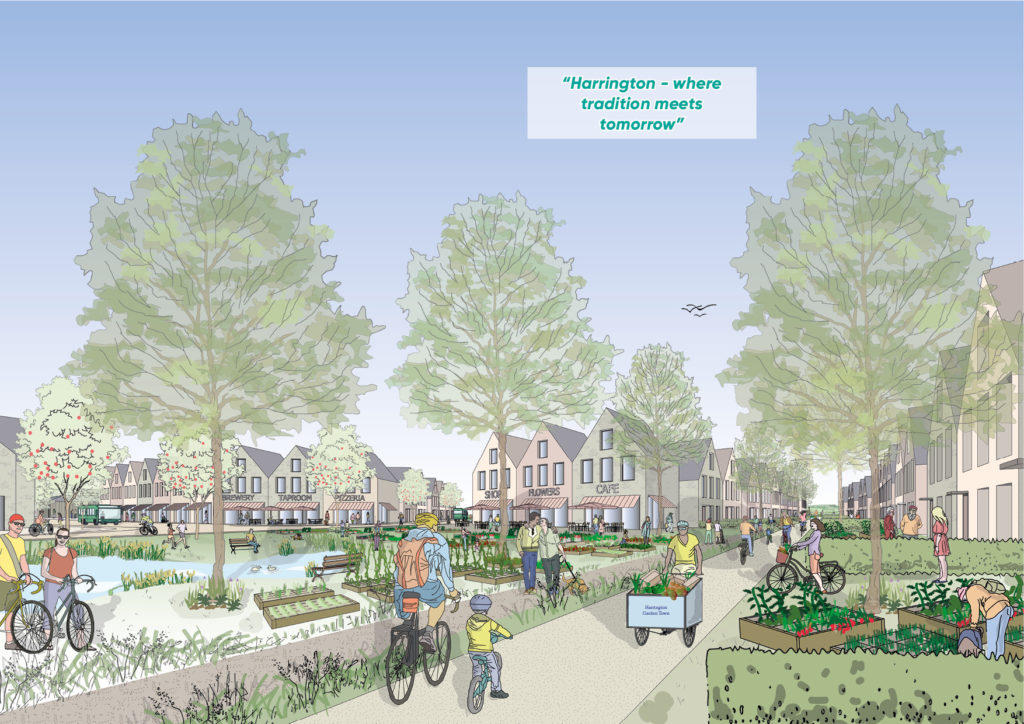?
How to build a sustainable settlement that doesn’t neglect its heritage?
?
How to build a sustainable settlement that doesn’t neglect its heritage?

Those behind Harrington, a planned new town of 6500 homes near Oxford, claim that a response to the climate emergency is within its DNA
‘New settlements must be designed in a way that is sensitive to local and global environmental challenges’ – Lord Matthew Taylor.
In a recent article https://ldn-collective.com/insights/lord-matthew-taylor-talks-about-harrington-where-tradition-meets-tomorrow/, Lord Matthew Taylor explains that the new age of settlement design should adopt a ‘holistic approach and build in solutions from the start, developing a model for a new way of living and a proving ground for new low and zero-carbon technologies, achieving and surpassing Oxfordshire’s ambitious goals for net-zero’.
While this might sound ambitious, Taylor suggests that the technology is already out there with other districts aiming for ‘2030 and 2035 for district-wide carbon neutrality.’ And rightly so, environmental and social wellbeing should work hand in hand.
‘Our vision for a new settlement at Harrington is a sustainable alternative, creating a 21st Century community that doesn’t destroy the setting of historic towns and villages and clog up their streets.’
However, communities are rarely new – in a sense, they’re never created but expanded. They grow and develop dependent on the needs of the time. It’s our job as designers, architects and planners to provide places that are deeply rooted in their heritage, cultural locality and have the potential to evolve sustainably over time. We should be ambitious enough to do so.
How Harrington responds to the current climate emergency has been split into a number of action including enhancing the natural environment, promoting sustainable mobility and connectivity and creating a flourishing community, embracing innovation and promoting a sustainable economy.
Additionally, three distinct stages are proposed in order to create a socially inclusive and sustainably motivated community:
ftwork believes that there may be some valuable takeaways from this, but only with clear provisos. How are we to ‘provide places that are deeply rooted in their heritage, cultural locality and have the potential to evolve sustainably over time’? An awareness of the challenge is not enough. Addressing the social aspects of the challenge requires us to build on local knowledge and work with who and what is already there. By understanding and valuing what already exists we can work collaboratively to create inclusive, happy and healthier places, with the necessary social infrastructure to add value and increase opportunities within communities like Harrington.
Yes, place-making and new homes must consider the historical values in existing communities, but it is just as important to meet the identified needs of communities, providing the flexibility to evolve and adapt over time as those needs change. We’ll be watching with interest how Harrington’s core sustainable values are incorporated and play out. Do they have the potential to be adopted more widely, perhaps even in cities?
Editors notes:
Lord Matthew Taylor is an expert in planning policy, a Senior Fellow at Cambridge University’s planning department, and an Honorary Member of the Royal Town Planning Institute <https://www.rtpi.org.uk> with his work rooted in the support of rural communities. For the past six years, Taylor has been working alongside the developer Summix and London Collective <https://summix.com>, a network of built environment experts and creatives to produce a 21st-century new community that is genuinely sustainable.
credits:
Image credit: Summix